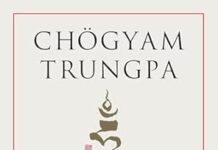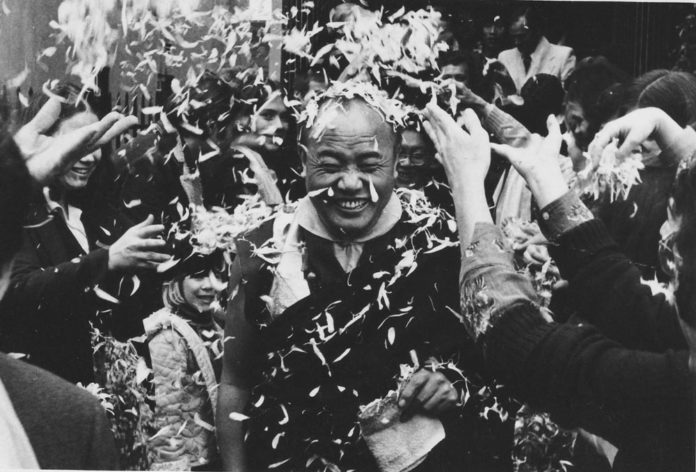
When the Vidyadhara Chögyam Trungpa Rinpoche came to the West, he did not demand or expect devotion from his students. But he taught tirelessly about the teachers of his lineage, and how genuine spiritual practice depends upon deep lineage connections. Gradually, over time, like a fine mist that eventually soaked us, devotion dawned on the students of Trungpa Rinpoche.
We came to understand that in order for the teachings to take root in our hearts and in our native soil, a relationship with the teacher and the larger lineage was necessary. The teacher needs to see the students as they are, and the student tunes into and connects with the mind and larger vision of the teacher. Communication was the central teaching here.
As our devotion increased in these early years, we came to regard Trungpa Rinpoche as the only and the everything. It seemed that he came out of nowhere, like a bolt of lightning. But there was a larger context behind and around his presence and activity. We were soon to learn much more about that context, as the Vidyadhara introduced us to the major figures within the Kagyu and Nyingma lineages in which he was thoroughly grounded, trained and ripened.

During the third and final tour to North America in 1980 by Rangjung Rigpe Dorje, His Holiness the 16th Karmapa, I served on the coordinating team from Vajradhatu that looked after arrangements for His Holiness and his entourage. In Tibet, the Vidyadhara had taken monastic vows as a teenager with His Holiness, and they spent time together in India after they both came out of Tibet.
For six months, our team traveled with His Holiness, from city to city, setting up households and teaching venues at many Dharmadhatus and dharma centers in North America. We made the complex logistical, security and political arrangements that were required, due to the Karmapa’s diplomatic status in the Kingdom of Bhutan, and his role as a widely respected world religious leader. In order to put together the infrastructure for the visit, we worked closely with federal, state and local authorities for His Holiness’s presence in each city, where he met with many religious and political leaders, as well as diplomats in New York and Washington D.C. In October of 1980, His Holiness and the Vidyadhara were guests at a congressional reception on Capitol Hill, hosted by Senator Charles Percy of Illinois, and attended by more than 100 members of Congress.

In the course of our work, we entered completely into the Karmapa’s mandala, and lived and worked within it. The Vidyadhara trained us carefully and precisely, and kept a sharp eye on all aspects of the tour, to make certain His Holiness was hosted in proper fashion. We learned how to serve His Holiness, and to take part in the great feast of devotion that he hosted wherever he went. By doing so we came to appreciate and understand better the role of lineage and devotion in the realization and transmission of dharma.
Our sangha as a whole was profoundly moved by His Holiness in the course of his three visits to North America. The community deeply loved and respected His Holiness, and we saw how the Vidyadhara expressed his own genuine and pure devotion towards His Holiness and his lineage. This in turn helped us to understand and appreciate our own heritage as members of the same dharma family.
A friend recently told me a story about how one of the Vidyadhara’s students entered the sitting room of the 16th Karmapa during his first visit in 1974. She saw the Vidyadhara prostrating to His Holiness, and was profoundly moved by this show of respect for His Holiness. At other times, the Vidyadhara put his head in the Karmapa’s lap, and cried like a baby. The Vidyadhara always received His Holiness in a formal way, welcoming him in the traditional manner for such occasions and making elaborate offerings. He attended teachings and abhishekas, shared his vision about teaching in the West, and visited at length with His Holiness and party at venues around North America. In 1980, the Vidyadhara left the Vajradhatu Seminary program to greet His Holiness when he arrived in New York City, and turned right around and quickly returned to the Seminary.

By the end, many students felt their devotion to the Karmapa was the same as, and inseparable from, their connection to the Vidyadhara. By hosting His Holiness, and the many other prominent Tibetan teachers who visited our community in these years, the Vidyadhara showed us the larger world that we were part of, but did not fully know.
Devotion, we learned, was not about fixation on one teacher or blind loyalty to an individual. In a talk from the Sadhana of Mahamudra Sourcebook, the Vidyadhara explains that he had fifteen gurus, including several main or root teachers. In addition to his closest teachers, he also had close dharmic friendships with many learned gurus, khenpos and lamas. About the time of the first visit by the Karmapa in 1974, the Vidyadhara shared this expansive view of lineage with some of his senior students:
The lineage is like the pipeline and the yidams are like the water running through it. To secure the pipeline, it is important to relate to all of the gurus in the lineage, not just one’s personal guru. The personality cult of one’s own guru is not relevant. You couldn’t get water without all the links…In the lineage tree, you don’t visualize your personal guru as a separate figure, but Vajradhara is the embodiment of the personal guru. Transmission is not dependent on personality.
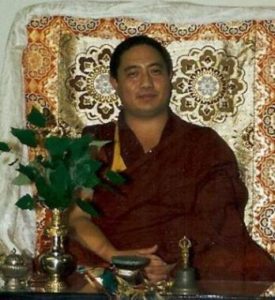
The Vidyadhara worked closely with the many hundreds of volunteers and staff during these visits, to create an appropriate environment to receive His Holiness. Just as a fine diamond needs a proper setting to be appreciated and enjoyed, so too, we learned from the Vidyadhara, His Holiness would need a proper seat, or “palace,” to fully manifest and communicate. This sacred world, with its elaborate protocol and service, the colorful brocades, the whole big show, was created to facilitate this communication and to connect us to the essence of our lineage as embodied by His Holiness.
From the beginning of his time in North America, the Vidyadhara shared with his students their “family history,” and the importance of knowing and connecting with our lineage teachers. He taught that devotion was at the very heart of dharma transmission and the source of blessings. In many early seminars, he taught with passion and urgency about Padmasambhava, Milarepa, Naropa and the many other beloved teachers of our Kagyu and Nyingma lineages. The Vidyadhara made these teachers and their stories come alive for his students. And he connected the past to the present by inviting and hosting many of his own teachers, and other accomplished dharma friends and colleagues. We came to know, respect and honor this rich dharmic heritage. In the recently published book by the Vidyadhara, Mishap Lineage: Transforming Confusion into Wisdom (page 10), the Vidyadhara explains that the point of this was “…to tell people that their lineage had good forefathers and that there is a good background, a good lineage, behind them. So it is a trustworthy situation.”

In his teaching, the Vidyadhara went into the very essence of devotion, and taught its inner meaning. The word for devotion in Tibetan is mögu. “Mö” means longing, “gu” means respect. So devotion brings humbleness and longing together. Humbleness is the absence of arrogance or self-importance, longing is admiration, wanting to mix your mind with the guru’s. What we call blessings are simply the natural ripening that takes place when this humble longing meets the sky-like mind and pure heart of the teacher. The blessings ripen us naturally, like the sun shining on plants. Communication takes place, as the student tunes into the vast mind and world of the guru. The Vidyadhara taught authentic devotion as nontheistic, that what we really long for is our own inherent wisdom. For him, there was no contradiction between devotion and the exercise of our intelligence, and he urged us to avoid a naïve, simplistic adoration, of the teacher.
The constant thread in the Vidyadhara’s teaching about the necessity of going beyond spiritual materialism created the ground for this key teaching on non-theistic devotion. Real communication between teacher and student can only take place when the student resolves and sees through the hunger for “more,” for “better,” for something out there that will improve things.
The Vidyadhara showed us that the practice of devotion is the ultimate antidote to ego clinging. Our petty, small-minded scheming and grasping are gradually exposed and challenged by an authentic guru. Humbleness and longing soften us up, so that we can relax our rigid sense of self and our personal baggage. Then maybe we can unmask and connect with the teacher.

But this opening to the teacher is not particularly fun or entertaining or romantic. The Vidyadhara was mainly interested in the real neurosis and “secret stash” that his students often kept hidden from view. We learned that the only real offering to the guru is, finally, our messy, ugly ego, and our passion, our aggression, our ignorance. This process is painful and embarrassing and we were sometimes left feeling naked and silly. The guru was most definitely not going to save us. Claustrophobia was a constant, and there was no place to hide. The Vidyadhara’s students lived in this tight place, where self-deception could not take root and the usual comforts of “home” were not to be found. We still live in this place.
In the source book entitled Selected Talks on Lineage and Devotion (Talk 3), the Vidyadhara says:
“The idea of lineage is that the lineage has also developed its own characteristic marks and styles. It has also developed its own pattern or system of working with our basic sanity and systems of all kinds have developed naturally and function by themselves. It has its own patterns. Usually those patterns are not entertaining. The patterns handed down from generation to generation are extremely painful, to the point of being unpleasant for our ego’s satisfaction. They are very tough, and embarrassingly right-to-the-point. It’s so immediate and direct and extremely irritating, because the techniques and the message of the lineage demands exposing ourselves and our egomaniac state of being—directly exposing ourselves constantly, completely, and also taking pride in that.”
In the Sadhana of Mahamudra Sourcebook (page 103) the Vidyadhara sums this up: “Only if we have an immense sense of devotion, only if we can actually give the background, the giver, are we ready to receive blessings, adhisthana…So the only way to receive the teachings is if you are not actually there.”
The Vidyadhara made the life stories of our lineage ancestors relevant and accessible for his students. The teachers are revered family members, not ancient, dusty icons or part of some historical or archaeological exercise. The way these teachers lived and practiced in their era helps us now, on our own paths, in our own time. Their life stories inspire understanding and appreciation for the nature and challenges of the path. By studying these teachers’ struggles, their passions, their humanness, as they engaged the teachings and traversed the path, their stories become our stories.
By the power of this unbroken lineage, the teachings and practices of our tradition are shared and passed along from generation to generation, through the centuries and across the continents. These teachings and practices are like 24-carat gold: pounded, refined and made pure after centuries of hard work and discipline. They have a long history of deep practice and realization behind them. In The Mishap Lineage (page 9), Trungpa Rinpoche defines lineage as “…a prolonged sense of commitment to humanity and to working with the neurosis of humanity.”
Every year, “Lineage and Devotion” was an important and popular course at the Vajradhatu seminary programs offered by the Vidyadhara. Students learned about nontheistic devotion, and the lore and history of their lineages. For many, this course was a key piece in their education as buddhists, and offered guidance and clues about how to enter the deeper waters of the vajrayana altogether.
On many occasions, the Vidyadhara spoke in a very personal, emotional way about what it was like to be with his own teachers, and how much he loved them. He would often cry when he talked about them. After all he went through and accomplished in his life, he still seemed to long for his teachers and he always missed them in some unfathomable, non-dual way.

His Holiness Dilgo Khyentse Rinpoche was a revered Nyingma scholar and teacher, and a highly accomplished dzogchen master in the 20th century. He first came to the U.S. in 1976, as a guest of the Vidyadhara. Through His Holiness, the sangha was introduced to the Nyingma side of the family. Khyentse Rinpoche was a very special and close teacher, friend and mentor for the Vidyadhara. He was also a renowned teacher for a generation of young Tibetan tulkus, and gave teachings to many senior teachers of all lineages and schools, including His Holiness the Dalai Lama. After the Vidyadhara’s parinirvana in 1987, Khyentse Rinpoche presided over the six weeks of ceremonies and practices, culminating in the cremation of the Vidyadhara.
Today, some of the close students of H.H. Dilgo Khyentse Rinpoche continue to carry on his legacy. H.E. Shechen Rabjam Rinpoche, Dilgo Khyentse Rinpoche’s grandson, has spent the past fifteen years taking responsibility for training and teaching Khyentse Yangsi Rinpoche, the incarnation of His Holiness. The Yangsi is currently visiting the West for the first time, with programs scheduled in Europe and North America. Dzongsar Khyentse Rinpoche and the Venerable Dzigar Kongtrul Rinpoche are widely revered and accomplished teachers who have fulfilled the wishes and vision of H.H. Dilgo Khyentse Rinpoche, and who have taught extensively in the West.

By bringing the Karmapa and Dilgo Khyentse Rinpoche into our community in the early years, the Vidyadhara filled in the picture about our lineages and our larger dharma family. For instance, in his early teachings on the Sadhana of Mahamudra, the Vidyadhara explained that the practice of this sadhana is based on the union of space, insight (“brains”) and crazy wisdom (connected with the Nyingma lineage) with emotion (“heart”), energy, and devotion (from the Kagyu side). By offering his students the presence and distinctive qualities of the Karmapa and Dilgo Khyentse Rinpoche, the Vidyadhara vividly pointed out this non-duality of space and energy. Along with his commentary and explanations on these topics, this fundamental teaching served as an important foundation for a more subtle understanding and view. In future years, this view served to inform and enrich our vajrayana practices. Of course, simple categories don’t usually hold in the vajrayana tradition, and things are all mixed together. The Kagyu lineage contains dzogchen teachings, such as the Karma Nyingtik of the Third Karmapa, and the Nyingma teachings talk about mahamudra.
The Vidyadhara emphasized this inseparability of the mahamudra teachings highlighted in the Kagyu lineage and the dzogchen or ati emphasis of the Nyingma. In the Sadhana of Mahamudra Sourcebook (page 16), Rinpoche states: “So that seems to be the general pattern: that there is a need for both approaches together. That makes the whole thing completely presentable and completely workable. If it were not for the mahamudra or devotional tradition, the maha ati or crazy wisdom tradition might produce a lot of fanatics, a lot of neurotics, quite possibly even a lot of suicides.”
The Vidyadhara did not want to leave to chance our relations with these important lineage teachers and the critical teachings and instructions they held. He wanted to create an institutional structure to ensure proper communication and connection with the lineages, and be certain that we were integrated with their activity. By creating an administrative mandala, and the office of External Affairs within that, he created a model for how lineage relations, and in fact diplomatic relations altogether, could be carried out so that autonomy and inter relatedness could effectively coexist.
After the 1980 tour by the Karmapa, I began to work full-time in the Office of External Affairs of Vajradhatu. This office was first established by the Vidyadhara in 1974 to support the early visits to Vajradhatu by the Karmapa and other teachers. Karl Springer was appointed as the first director of the office by the Vidyadhara. Mr. Springer ably led this department until 1990. I took over at that time, and coordinated the renamed Office of International Affairs until last year, when it was dissolved, and its activity was folded into the Office of the President of Shambhala.
The Vidyadhara created the Vajradhatu Office of External Affairs as a kind of “foreign ministry,” and he fully and personally supported its work in bringing Shambhala into the larger world. The mission of the office was to nurture and build the key dharmic relationships, and to connect with the larger political and diplomatic world as well, as these were important in facilitating and supporting visits by the Tibetan teachers and the broader vision of Shambhala. Over the years, we worked with H.H. the Dalai Lama’s government-in-exile, the United Nations Mission of the Kingdom of Bhutan, the embassy of India, and the U.S. Department of State. The office was staffed with four full-time members, who coordinated several major teaching visits each year, managed media relations, and nurtured our friendships with the many teachers and dharma communities with whom we had connections, including working with other buddhist sanghas on various dharma projects.
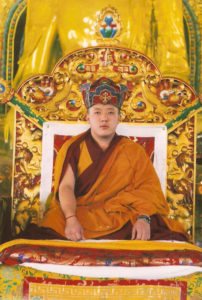
Representatives from the Office of External Affairs also traveled regularly to India, Nepal and Bhutan, as “ambassadors” to that part of the world, taking part in international buddhist conferences, meeting with teachers and other officials, and undertaking various missions on behalf of the Vidyadhara. In December, 1981, the office arranged for the Vidyadhara and a delegation to take part in the funeral ceremonies of His Holiness Karmapa at Rumtek Monastery in Sikkim, India.
The Vidyadhara was a master diplomat and strategist. By training and by nature, he knew how to move within complex political and diplomatic environments, without being sidetracked or bogged down in political quicksand. He helped guide our external relations, and he navigated a steady course as he carefully built strong and lasting bridges with many allies, partners and friends. These relationships supported the sangha in both the spiritual and political realms. He was hands-on in teaching us how to handle the diplomacy involved in this work.
The Vidyadhara saw clearly that it was essential to keep strong ties with our lineage teachers, while not losing track of the underlying dharmic purpose and logic for it. The Vidyadhara taught us how to manage these relations, and to avoid harmful entanglements. Having trained and worked with us, he trusted the staff in the office. While keeping a close eye on our work, he also gave the staff considerable responsibility and authority to manage these external relations.
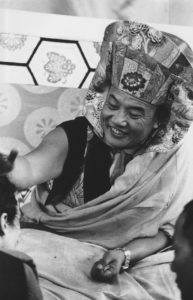
The Vidyadhara opened our world in the West to his many friends and colleagues from the “Old Country.” He drew on his longtime friendships and dharma connections, and brought in teachers to share their wisdom, knowledge and experience. He viewed these many visits primarily as a supplement and support for the dharma training he offered, as well as help with his larger vision altogether. In 1981, the Vidyadhara invited His Holiness the Dalai Lama to Colorado for a major visit. A few years later, he asked the Venerable Khenchen Thrangu Rinpoche to establish monastic training at Gampo Abbey in Nova Scotia, and to teach the Six Yogas and mahamudra. Before he would confer the first Chakrasamvara abhisheka in the mid 1980s, the Vidyadhara supplicated the Venerable Tenga Rinpoche (the former Dorje Loppon at the Karmapa’s seat in Sikkim, India) to build a three-dimensional mandala, and to give extensive teachings on this practice. After several years, Tenga Rinpoche agreed, came to Boulder in 1984, and lived at Marpa House for six weeks. After Tenga Rinpoche completed the mandala and gave the instructions on the practice, the Vidyadhara finally conferred the Chakrasamvara abhisheka. Over several visits, H.H. Dilgo Khyentse Rinpoche gave Longchen Nyingthik empowerments and teachings. There were many other teachers who taught at the invitation of the Vidyadhara. He requested a wide range of accomplished and learned teachers to share their realization, their specialties, and to enrich and supplement his own curriculum and practice path.
Yangsi Rinpoche is visiting the West for the first time this summer, with several stops in Europe in July, followed by a tour of North America in August. He will be giving teachings and empowerments at each location, and there will be a screening of a new film on the life of Dilgo Khyentse Rinpoche and a display of sacred relics. For more information visit Khyentse Rinpoche’s visits to the West: 1976 – 2010 on the Chronicles.
Visits by our lineage teachers uplifted our community in many ways. The Dorje Kasung took form during the early visits of the Karmapa and Dilgo Khyentse Rinpoche, when proper protection was needed to create a spotless teaching mandala and environment. Elegant service to the teachers was essential to create the ground for communication and devotion, and this helped develop more refined service within the Kalapa Court. The Office of External Affairs provided a protocol manual to our local centers, so that this training could be shared with other centers hosting visits by teachers.
In buddhist lands there are many stories of teachers, pilgrims, and practitioners meeting on the road during their travels. A common query in such situations is “Who are your teachers? What is your lineage?” Even today, these questions retain their relevance and meaning. Close connections with an authentic lineage is how the Buddha’s teachings are protected from corruption, dilution, distortion and/or charlatanism. It is what keeps it all honest and above board. Good teachers always adapt and update dharma teachings to fit the current needs and cultural framework of their students. But the essence, the marrow of the teachings that is inherited from one’s teachers must never be lost or forgotten. This is why devotion to our teachers and our lineages is at the very heart of the path. To ensure the integrity of the transmission, the vajrayana put primary importance on oral or “ear-whispered” teachings that jump directly from teacher to student. This provides the “language” and the medium for the transmission of wisdom mind, beyond wishful thinking, fancy new ideas, or a merely conceptual understanding of the dharma.
The Buddha started it all 2,500 years ago. He simply sat down and talked with people, explained what he understood, and communicated directly with the humans he encountered. In turn, they taught other humans. This is lineage. Devotion is the spark, the juice that keeps it alive and active.
It is often said that khaki never goes out of style. In the same way, devotion and lineage will never wane in importance, no matter how many changes the transmission of dharma undergoes or where dharma is taught.





